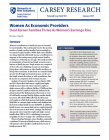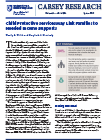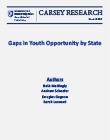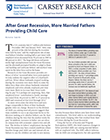Publications

July 14, 2015
The Healthy, Hunger-Free Kids Act of 2010, which authorizes funding for federal nutrition programs (including the National School Lunch Program; the School Breakfast Program; the Special Supplemental Nutrition Program for Women, Infants, and Children; the Summer Food Service Program; and the Child and Adult Care Food Program), is set to expire on September 30, 2015.1 The reauthorization process...

June 30, 2015
Women’s contributions to family income are essential for most families. This is obviously true for the growing number of single-mother families, but increasingly so for married couple families. While dual-earner families are doing relatively well, family income overall has been stagnant or decreasing among single-earner families, resulting in a widening income gap. This study provides an...

June 16, 2015
The adverse effects of poverty on child and adolescent development are well documented and have been of interest to policy makers for several decades.1 Childhood poverty has a number of lasting impacts, including negative educational and cognitive outcomes, social and emotional behavior problems, poor adult economic outcomes, and health problems.2 For some children, these challenges are coupled...

June 9, 2015
Recognizing that adequate health care is key to childhood development and long-term health, policy makers expanded public programs to provide children with health insurance: first, Medicaid in 1965 and, in 1997, the State Children’s Health Insurance Program (SCHIP). In April of 2015, Congress renewed SCHIP for two additional years. Therefore, providing children with health coverage has been...

May 19, 2015
In the several years since the Great Recession, New Hampshire, like the nation, has witnessed and experienced growing economic disadvantage. The state’s poverty level stands at 8.4 percent, and child poverty increased from about 8 percent in 2000 to nearly 10 percent in 2012.1 Some areas of the state have been hit harder than others. In the state’s largest city of Manchester, for instance,...

March 9, 2015
Public discourse on economics in the United States, and around the world, often focuses on rising income and wealth inequality. The “Occupy” movement drew great attention to the rising fortunes of the top one percent while middle- and lower-income Americans lost ground. Vast scholarly, political, and media attention is focused on issues of growing inequality and implications for broader societal...

February 11, 2015
This brief assesses trends in access to, enrollment in, and success in Advanced Placement (AP) coursework in relation to school district poverty, racial composition, and urbanicity. It uses data merged from the 2011–2012 Civil Rights Data Collection (CRDC), the 2012 Small Area Income and Poverty Estimates (SAIPE), and the 2010 Decennial U.S. Census. Authors Douglas Gagnon and Marybeth Mattingly...

February 3, 2015
The U.S. economy lost 8.7 million jobs between December 2007 and January 2010.1 Sixty-nine percent of the jobs lost during the recession were held by men, 2 and the employment rate of married fathers (whether working full or part time) with employed wives decreased from 92 percent in 2005 to 88 percent in 2011.3 The large job losses and persistently high unemployment from the Great Recession and...

December 16, 2014
In this report, author Cynthia Needles Fletcher explores the role of "place" in shaping rural residents'-and in particular low-income residents'-futures. The analysis draws from interviews with residents and community key informants in Hampton, Iowa in an original study in 1997 and again in 2012-13.

October 28, 2014
In 2013, Carsey released a brief that analyzed rates of restraint and seclusion using a large, nationally representative data set of U.S. school districts. This brief, which analyzes a more comprehensive data set and the most current Civil Rights Data Collection, serves as a follow-up to the previous brief.
